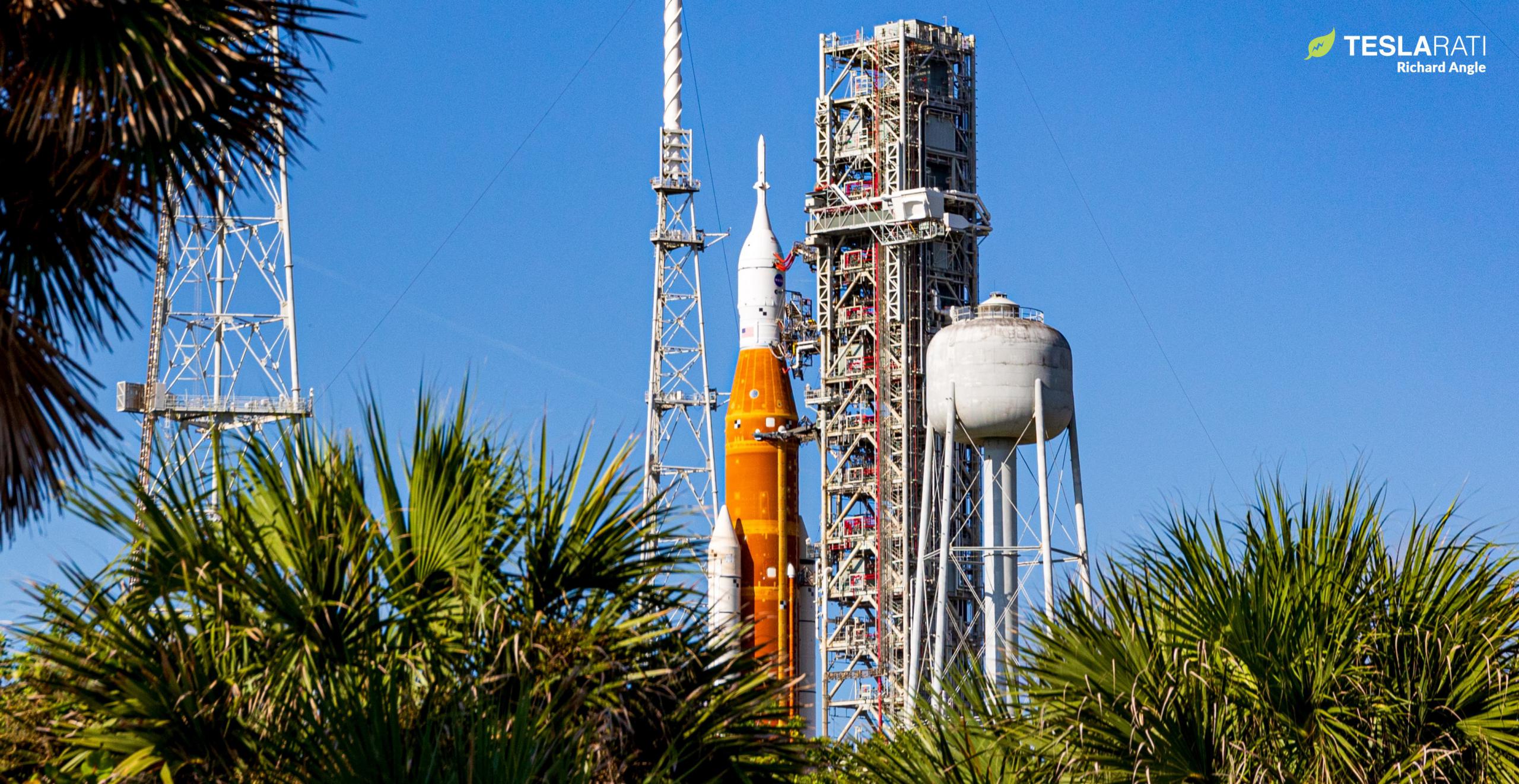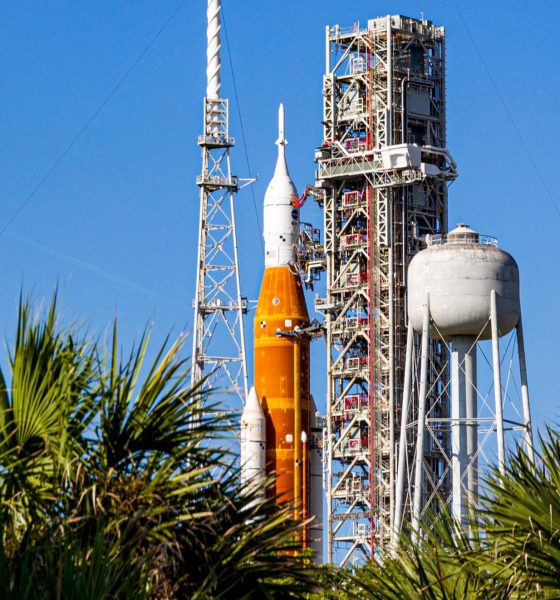

News
NASA’s SLS Moon rocket almost aces vital prelaunch test on 7th try
Following several incomplete attempts in April, June, August, and September, NASA’s first Space Launch System (SLS) Moon rocket has almost aced a vital prelaunch test on the seventh try.
NASA says that “all objectives were met” during the ten-hour test, which wrapped up around 4:30 pm EDT (20:30 UTC) on Wednesday, September 21st. Despite the rocket running into multiple additional issues, some old and others new, the agency was confident enough in the preliminary results of the wet dress rehearsal (WDR) – deemed a “cryogenic demonstration test” – to reaffirm that it’s still working towards a third launch attempt as early as September 27th.
That launch date is not set in stone, but NASA also hasn’t ruled out the window after the latest round of SLS testing. The agency will host a press conference on Friday, September 23rd, to provide its final decision and offer more details about the seventh wet dress rehearsal.
Despite NASA’s apparent confidence after the test, which was admittedly smoother than most previous SLS tests at the launch pad, it was far from smooth. The immediate story of the “cryogenic demonstration test” dates back to the SLS Artemis I rocket’s second so-called “launch attempt” on September 3rd. During that attempt, the launch was aborted well before SLS was ready when NASA detected a major hydrogen fuel leak around one of the quick-disconnect umbilical panels that fuels and drains the rocket. Remote troubleshooting was unable to solve the problem, forcing NASA to stand down.
Over the last few weeks, teams inspected, tested, and repaired the faulty Tail Service Mast Umbilical (TSMU), preparing for a cryogenic proof test meant to verify that the issue was fixed. During that September 21st test, the TSMU still leaked significantly for the whole duration, but it did so more predictably and – unlike prior leaks – never violated the limits that would trigger a launch abort.
But near the end, a different umbilical panel developed a significant hydrogen leak that did violate those launch constraints, meaning that NASA would have likely had to stand down yet again if it had attempted to launch before completing additional testing. The test was completed successfully, but its goals and constraints were not the same as those facing a launch.
A NASA-developed rocket leaking hydrogen is unfortunately a tale as old as time. That the agency that struggled with hydrogen leaks throughout the 30-year career of the Space Shuttle appears to be just as flabbergasted by nearly identical problems on a new rocket – SLS – that has Shuttle ‘heritage’ on almost every square inch is not surprising, even if it is somewhat embarassing.
Liquid hydrogen fuel always has been and likely always will be a massive pain to manage in any rocket, but especially in a large rocket. As the smallest element in the universe, it is fundamentally leak-prone. Combined with the fact that it only remains liquid below the extraordinarily low temperature of -253°C (-423°F), generates ultra-flammable hydrogen gas as it continually attempts to warm to a more stable temperature, and naturally embrittles most metals, it’s an engineering nightmare by almost every measure.
For all that pain, hydrogen does provide rocket engineers exceptional efficiency when properly exploited, but even that positive aspect is often diminished by hydrogen’s ultra-low density. For rocket stages that have already reached orbit, hydrogen-oxygen propellant offers unbeatable efficiency. But for a rocket stage that will never be used in orbit, like the SLS core stage, hydrogen fuel is rarely worth the tradeoffs – a reality that SLS is unfortunately providing a strong reminder of.
Demonstrating the Groundhog Day-esque nature of NASA rockets and hydrogen leaks, the same leaky TSMU panel that aborted SLS’ September 3rd launch attempt (sixth WDR) and had to be fixed and retested on September 21st also caused a hydrogen leak that partially aborted the rocket’s third wet dress rehearsal attempt in April 2022. NASA then rolled the rocket back to the Vehicle Assembly Building (VAB), where workers spent almost two months inspecting and reworking the fuel TSMU and fixing other issues. During its first test (WDR #4) after rolling back to the pad in June, the same fuel TSMU leaked and NASA had to return the rocket to the VAB again to fix the problem.
The fuel TSMU then leaked on the SLS rocket’s first launch attempt (really WDR #5), but the problem was resolved and was not what caused NASA to stand down. It was, however, a primary reason behind NASA’s second aborted launch attempt (WDR #6). With any luck, the eighth time will be the charm.

Elon Musk
Elon Musk confirms xAI’s purchase of five 380 MW natural gas turbines
The deal, which was confirmed by Musk on X, highlights xAI’s effort to aggressively scale its operations.

xAI, Elon Musk’s artificial intelligence startup, has purchased five additional 380 MW natural gas turbines from South Korea’s Doosan Enerbility to power its growing supercomputer clusters.
The deal, which was confirmed by Musk on X, highlights xAI’s effort to aggressively scale its operations.
xAI’s turbine deal details
News of xAI’s new turbines was shared on social media platform X, with user @SemiAnalysis_ stating that the turbines were produced by South Korea’s Doosan Enerbility. As noted in an Asian Business Daily report, Doosan Enerbility announced last October that it signed a contract to supply two 380 MW gas turbines for a major U.S. tech company. Doosan later noted in December that it secured an order for three more 380 MW gas turbines.
As per the X user, the gas turbines would power an additional 600,000+ GB200 NVL72 equivalent size cluster. This should make xAI’s facilities among the largest in the world. In a reply, Elon Musk confirmed that xAI did purchase the turbines. “True,” Musk wrote in a post on X.
xAI’s ambitions
Recent reports have indicated that xAI closed an upsized $20 billion Series E funding round, exceeding the initial $15 billion target to fuel rapid infrastructure scaling and AI product development. The funding, as per the AI startup, “will accelerate our world-leading infrastructure buildout, enable the rapid development and deployment of transformative AI products.”
The company also teased the rollout of its upcoming frontier AI model. “Looking ahead, Grok 5 is currently in training, and we are focused on launching innovative new consumer and enterprise products that harness the power of Grok, Colossus, and 𝕏 to transform how we live, work, and play,” xAI wrote in a post on its website.
Elon Musk
Elon Musk’s xAI closes upsized $20B Series E funding round
xAI announced the investment round in a post on its official website.

xAI has closed an upsized $20 billion Series E funding round, exceeding the initial $15 billion target to fuel rapid infrastructure scaling and AI product development.
xAI announced the investment round in a post on its official website.
A $20 billion Series E round
As noted by the artificial intelligence startup in its post, the Series E funding round attracted a diverse group of investors, including Valor Equity Partners, Stepstone Group, Fidelity Management & Research Company, Qatar Investment Authority, MGX, and Baron Capital Group, among others.
Strategic partners NVIDIA and Cisco Investments also continued support for building the world’s largest GPU clusters.
As xAI stated, “This financing will accelerate our world-leading infrastructure buildout, enable the rapid development and deployment of transformative AI products reaching billions of users, and fuel groundbreaking research advancing xAI’s core mission: Understanding the Universe.”
xAI’s core mission
Th Series E funding builds on xAI’s previous rounds, powering Grok advancements and massive compute expansions like the Memphis supercluster. The upsized demand reflects growing recognition of xAI’s potential in frontier AI.
xAI also highlighted several of its breakthroughs in 2025, from the buildout of Colossus I and II, which ended with over 1 million H100 GPU equivalents, and the rollout of the Grok 4 Series, Grok Voice, and Grok Imagine, among others. The company also confirmed that work is already underway to train the flagship large language model’s next iteration, Grok 5.
“Looking ahead, Grok 5 is currently in training, and we are focused on launching innovative new consumer and enterprise products that harness the power of Grok, Colossus, and 𝕏 to transform how we live, work, and play,” xAI wrote.
Investor's Corner
Tesla gets price target bump, citing growing lead in self-driving

Tesla (NASDAQ: TSLA) stock received a price target update from Pierre Ferragu of Wall Street firm New Street Research, citing the company’s growing lead in self-driving and autonomy.
On Tuesday, Ferragu bumped his price target from $520 to $600, stating that the consensus from the Consumer Electronics Show in Las Vegas was that Tesla’s lead in autonomy has been sustained, is growing, and sits at a multiple-year lead over its competitors.
CES 2026 validates Tesla’s FSD strategy, but there’s a big lag for rivals: analyst
“The signal from Vegas is loud and clear,” the analyst writes. “The industry isn’t catching up to Tesla; it is actively validating Tesla’s strategy…just with a 12-year lag.”
The note shows that the company’s prowess in vehicle autonomy is being solidified by lagging competitors that claim to have the best method. The only problem is that Tesla’s Vision-based approach, which it adopted back in 2022 with the Model 3 and Model Y initially, has been proven to be more effective than competitors’ approach, which utilizes other technology, such as LiDAR and sensors.
Currently, Tesla shares are sitting at around $433, as the company’s stock price closed at $432.96 on Tuesday afternoon.
Ferragu’s consensus on Tesla shares echoes that of other Wall Street analysts who are bullish on the company’s stock and position within the AI, autonomy, and robotics sector.
Dan Ives of Wedbush wrote in a note in mid-December that he anticipates Tesla having a massive 2026, and could reach a $3 trillion valuation this year, especially with the “AI chapter” taking hold of the narrative at the company.
Ives also said that the big step in the right direction for Tesla will be initiating production of the Cybercab, as well as expanding on the Robotaxi program through the next 12 months:
“…as full-scale volume production begins with the autonomous and robotics roadmap…The company has started to test the all-important Cybercab in Austin over the past few weeks, which is an incremental step towards launching in 2026 with important volume production of Cybercabs starting in April/May, which remains the golden goose in unlocking TSLA’s AI valuation.”
Tesla analyst breaks down delivery report: ‘A step in the right direction’
Tesla has transitioned from an automaker to a full-fledged AI company, and its Robotaxi and Cybercab programs, fueled by the Full Self-Driving suite, are leading the charge moving forward. In 2026, there are major goals the company has outlined. The first is removing Safety Drivers from vehicles in Austin, Texas, one of the areas where it operates a ride-hailing service within the U.S.
Ultimately, Tesla will aim to launch a Level 5 autonomy suite to the public in the coming years.








